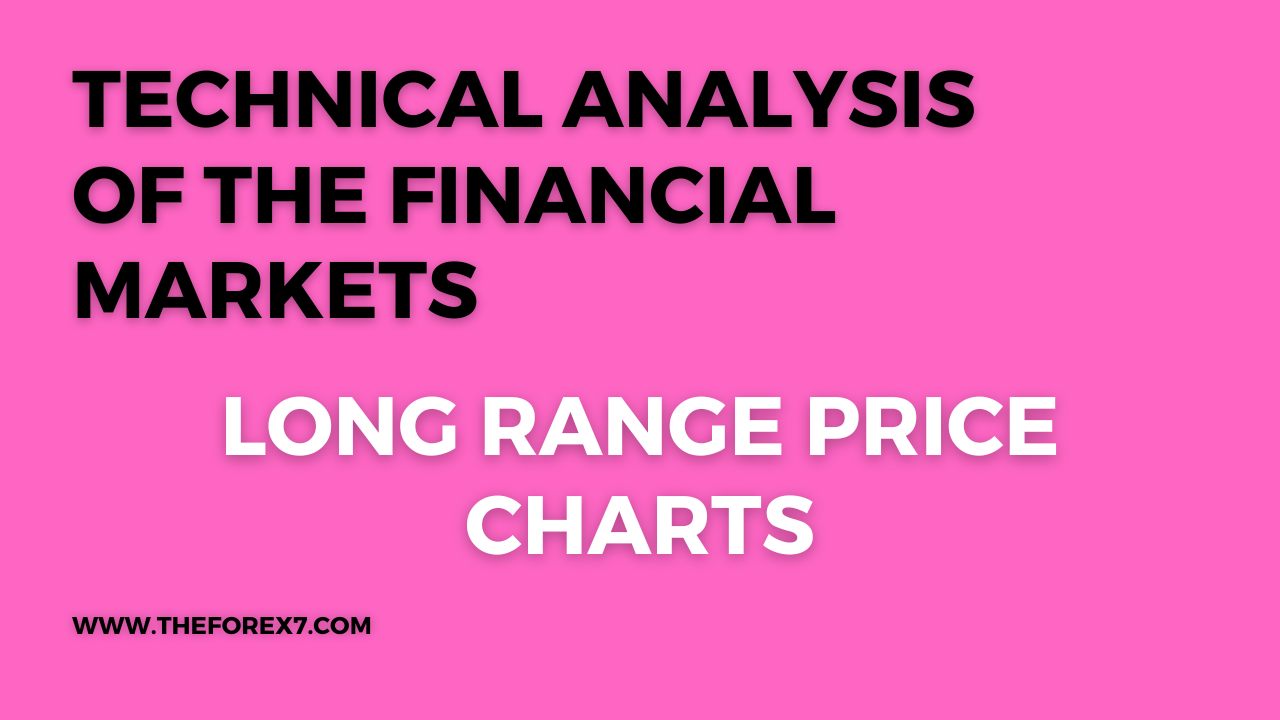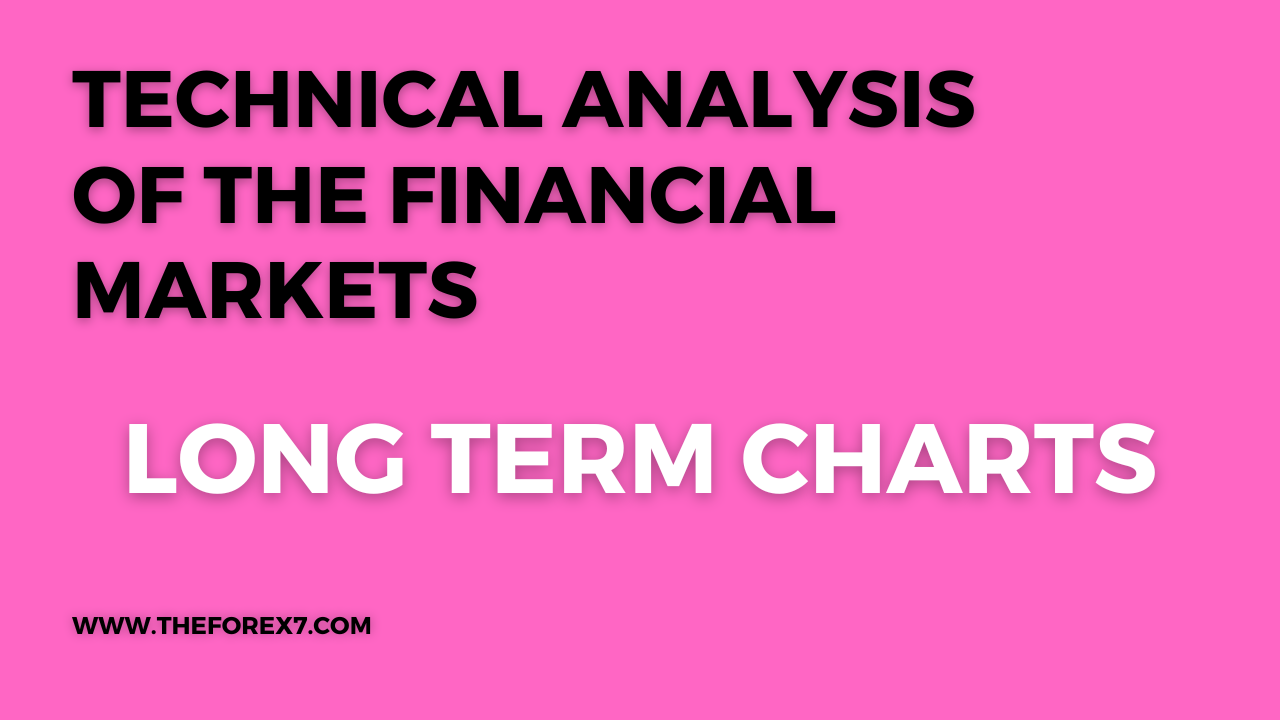Introduction: Long Range Price Charts
Market technician, Financial markets, Daily bar chart, Price action, Market trend
Course: [ Technical Analysis of the Financial Markets : Chapter 8: Long Term Charts ]

The daily bar chart usually covers a period of only six to nine months. However, because most traders confine their interest to relatively short term market action, daily bar charts have gained wide acceptance as the primary working tool of the chartist.
INTRODUCTION
Of
all the charts utilized by the market technician for forecasting and trading
the financial markets, the daily bar chart is by far the most popular. The
daily bar chart usually covers a period of only six to nine months. However,
because most traders confine their interest to relatively short term market
action, daily bar charts have gained wide acceptance as the primary working
tool of the chartist.
The
average trader's dependence on these daily charts, however, and the
preoccupation with short term market behavior, cause many to overlook a very
useful and rewarding area of price charting—the use of weekly and monthly
charts for longer range trend analysis and forecasting.
The
daily bar chart covers a relatively short period of time in the life of any
market. A thorough trend analysis of a market, however, should include some
consideration of how the daily market price is moving in relation to its long
range trend structure. To accomplish that task, longer range charts must be
employed. Whereas on the daily bar chart each bar represents one day's price
action, on the weekly and monthly charts each price bar represents one week's
and one month's price action, respectively. The purpose of weekly and monthly
charts is to compress price action in such a way that the time horizon can be
greatly expanded and much longer time periods can be studied.
THE IMPORTANCE OF LONGER RANGE PERSPECTIVE
Long
range price charts provide a perspective on the market trend that is impossible
to achieve with the use of daily charts alone. During our introduction to the
technical philosophy in Chapter 1,
it was pointed out that one of the greatest advantages of chart analysis is the
application of its principles to virtually any time dimension, including long
range forecasting. We also addressed the fallacy, espoused by some, that
technical analysis should be limited to short term "timing" with
longer range forecasting left to the fundamental analyst.
The
accompanying charts will demonstrate that the principles of technical
analysis—including trend analysis, support and resistance levels, trendlines,
percentage retracements, and price patterns—lend themselves quite well to the
analysis of long range price movements. Anyone who is not consulting these
longer range charts is missing an enormous amount of valuable price
information.
CONSTRUCTION OF CONTINUATION CHARTS FOR FUTURES
The
average futures contract has a trading life of about a year and a half before
expiration. This limited life feature poses some obvious problems for the
technician interested in constructing a long range chart going back several
years. Stock market technicians don't have this problem. Charts are readily
available for individual common stocks and the market averages from the
inception of trading. How then does the futures technician construct longer
range charts for contracts that are constantly expiring?
The
answer is the continuation chart. Notice the emphasis on the word "continuation." The technique most commonly
employed is simply to link a number of contracts together to provide
continuity. When one contract expires, another one is used. In order to
accomplish this, the simplest method, and the one used by most chart services,
is to always use the price of the nearest expiring contract. When that nearest
expiring contract stops trading, the next in line becomes the nearest contract
and is the one plotted.
Other Ways to Construct Continuation Charts
The
technique of linking prices of the nearest expiring contracts is relatively
simple and does solve the problem of providing price continuity. However, there
are some problems with that method. Sometimes the expiring contract may be trading
at a significant premium or discount to the next contract, and the changeover
to the new contract may cause a sudden price drop or jump on the chart. Another
potential distortion is the extreme volatility experienced by some spot
contracts just before expiration.
Futures
technicians have devised many ways to deal with these occasional distortions.
Some will stop plotting the nearest contract a month or two before it expires
to avoid the volatility in the spot month. Others will avoid using the nearest
contract altogether and will instead chart the second or third contract.
Another method is to chart the contract with the highest open interest on the
theory that that delivery month is the truest representation of market value.
Continuation
charts can also be constructed by linking specific calendar months. For
example, a November soybean continuation chart would combine only the historic
data provided by each successive year's November soybean contract. (This
technique of linking specific delivery months was favored by W.D. Gann.) Some
chartists go even further by averaging the prices of several contracts, or
constructing indices that attempt to smooth the changeover by making
adjustments in the price premium or discount.
THE PERPETUAL CONTRACT™
An
innovative solution to the problem of price continuity was developed by Robert
Pelletier, president of Commodity Systems, Inc., a commodity and stock data
service (CSI. 200 W. Palmetto Park Road, Boca Raton, FL 33422), called the
Perpetual Contract.™ ("Perpetual Contract™ " is a registered
trademark of that firm.)
The
purpose of the Perpetual Contract™ is to provide years of futures price history
in one continuous time series. That is accomplished by constructing a time
series based on a constant forward time period. For example, the series would
determine a value three months or six months into the future. The time period
varies and can be chosen by the user. The Perpetual Contract™ is constructed by
taking a weighted average of two futures contracts that surround the time
period desired.
The
value for the Perpetual Contract™ is not an actual price, but a weighted
average of two other prices. The main advantage of the Perpetual Contract™ is
that it eliminates the need for using only the nearest expiring contract and
smoothes out the price series by eliminating the distortions that can take
place during the transition between delivery months. For chart analysis purposes,
the nearest-month continuation charts published by chart services are more than
adequate. A continuous price series, however, is more useful for back-testing
trading systems and indicators. A more complete explanation of ways to
construct continuous futures contracts is provided by Greg Morris in Appendix
D.
LONG TERM TRENDS DISPUTE RANDOMNESS
The
most striking features of long range charts is that not only are trends very
clearly defined, but that long range trends often last for years. Imagine
making a forecast based on one of these long range trends, and not having to
change that forecast for several years!
The
persistence of long range trends raises another interesting question that
should be mentioned—the question of randomness. While technical analysts do
not subscribe to the theory that market action is random and unpredictable, it
seems safe to observe that whatever randomness does exist in price action is
probably a phenomenon of the very short term. The persistence of existing
trends over long periods of time, in many cases for years, is a compelling
argument against the claims of Random Walk Theorists that prices are serially
independent and that past price action has no effect on future price action.
PATTERNS ON CHARTS: WEEKLY AND MONTHLY REVERSALS
Price
patterns appear on the long range charts, which are interpreted in the same
way as on the daily charts. Double tops and bottoms are very prominent on
these charts, as are head and shoulder reversals. Triangles, which are usually
continuation patterns, are frequently seen.
Another
pattern that occurs quite frequently on these charts is the weekly and monthly
reversal. For example, on the monthly chart, a new monthly high followed by a
close below the previous month's close often represents a significant turning
point, especially if it occurs near a major support or resistance area. Weekly
reversals are quite frequent on the weekly charts. These patterns are the
equivalent of the key reversal day on the daily charts, except that on the long
range charts these reversals carry a great deal more significance.
LONG-TERM TO SHORT-TERM CHARTS
It's
especially important to appreciate the order in which price charts should be
studied in performing a thorough trend analysis. The proper order to follow in
chart analysis is to begin with the long-range and gradually work to the near
term. The reason for this should become apparent as one works with different time dimensions. If the analyst begins with only the near-term
picture, he or she is forced to constantly revise conclusions as more price
data is considered. A thorough analysis of a daily chart may have to be
completely redone after looking at the long-range charts. By starting with the
big picture, going back as far as 20 years, all data to be considered are
already included in the chart and a proper perspective is achieved. Once the
analyst knows where the market is from a longer range perspective, he or she
gradually "zeros in" on the shorter term.
The
first chart to be considered is the 20 year monthly chart. The analyst looks
for the more obvious chart patterns, major trendlines, or the proximity of
major support or resistance levels. He or she then consults the most recent
five years on the weekly chart, repeating the same process. Having done that,
the analyst narrows his or her focus to the last six to nine months of market
action on the daily bar chart, thus going from the "macro" to the "micro" approach.
If the trader wants to proceed further, intraday charts can then be consulted
for an even more microscopic study of recent action.
WHY SHOULD LONG RANGE CHARTS BE ADJUSTED FOR INFLATION?
A
question often raised concerning long term charts is whether or not historic
price levels seen on the charts should be adjusted for inflation. After all,
the argument goes, do these long range peaks and troughs have any validity if
not adjusted to reflect the changes in the value of the U.S. dollar? This is a
point of some controversy among analysts.
I
do not believe that any adjustment is necessary on these long range charts for
a number of reasons. The main reason is my belief that the markets themselves
have already made the necessary adjustments. A currency declining in value
causes commodities quoted in that currency to increase in value. The declining
value of the dollar, therefore, would contribute to rising commodity prices. A
rising dollar would cause the price of most commodities to fall.
The
tremendous price gains in commodity markets during the 1970s and declining
prices in the 1980s and 1990s are classic examples of inflation at work. To
have suggested during the 1970s that commodity price levels that had doubled
and tripled in price should then be adjusted to reflect rising inflation would
make no sense at all. The rising commodity markets already were a manifestation
of that inflation. Declining commodity markets since the 1980s reflect a long
period of disinflation. Should we take the price of gold, which is now worth
less than half of its value in 1980, and adjust it to reflect the lower
inflation rate? The market has already taken care of that.
The
final point in this debate goes to the heart of the technical theory, which
states that price action discounts everything, even inflation. All financial
markets adjust to periods of inflation and deflation and to changes in currency
values. The real answer to whether long range charts should be adjusted for
inflation lies in the charts themselves. Many markets fail at historic
resistance levels set several years earlier and then bounce off support levels
not seen in several years. It's also clear that falling inflation since the
early 1980s has helped support bull markets in bonds and stocks. It would seem
that those markets have already made their own inflation adjustment. (See Figure 8.1.)

Figure
8.1 The gold price peak in 1980 ushered in two decades of low inflation. Low inflation
normally causes falling gold prices and rising stock prices as this chart
shows. Why adjust the charts again for inflation? It’s already been done.
Technical Analysis of the Financial Markets : Chapter 8: Long Term Charts : Tag: Technical Analysis, Stocks : Market technician, Financial markets, Daily bar chart, Price action, Market trend - Introduction: Long Range Price Charts

